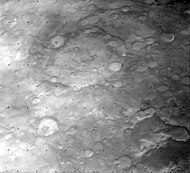Cassini (Martian Crater)
The crater measures approximately 415 kilometers in diameter and can be found at 327.9°W and 23.4°N. It is in the Arabia quadrangle of Mars. Pictures of small craters on the floor of Cassini reveal multiple layers. Some of these layers can be easily seen in the pictures below. Many places on Mars show rocks arranged in layers. Rock can form layers in a variety of ways. Volcanoes, wind, or water can produce layers. A detailed discussion of layering with many Martian examples can be found in Sedimentary Geology of Mars.
Recent research leads scientists to believe that some of the craters in Arabia may have held huge lakes. Cassini Crater probably once was full of water since its rim seems to have been breached by the waters. Both inflow and outflow channels have been observed on its rim. The lake would have contained more water than Earth's Lake Baikal, our largest freshwater lake by volume.
Many craters once contained lakes.
-
Oblique view of Cassini and vicinity from Viking Orbiter 1, also showing Pasteur crater (lower left), Indus Vallis (right), Scamander Vallis (bottom), and Arago crater (bottom right corner)
-
Viking Orbiter 1 mosaic
-
Map of Arabia quadrangle with major craters. Cassini is in the upper right.
-
Crater in the middle of Cassini crater, as seen by HiRISE.
-
Layers in a crater on the floor of Cassini Crater, as seen by HiRISE, under HiWish program
See also
References
- ^ "Gazetteer of Planetary Nomenclature | Cassini". usgs.gov. International Astronomical Union. Retrieved 24 August 2017.
- ^ "Archived copy". Archived from the original on 2006-10-09. Retrieved 2007-02-03.
{{cite web}}: CS1 maint: archived copy as title (link) - ^ "HiRISE – High Resolution Imaging Science Experiment". University of Arizona. Retrieved 2012-08-04.
- ^ Grotzinger, J. and R. Milliken (eds.). 2012. Sedimentary Geology of Mars. SEPM.
- ^ Fassett, C. and J. Head III. 2008. Valley network-fed, open-basin lakes on Mars: Distribution and implications for Noachian surface and subsurface hydrology. Icarus: 198. 39-56.
- ^ Cabrol, N. and E. Grin. 2001. The Evolution of Lacustrine Environments on Mars: Is Mars Only Hydrologically Dormant? Icarus: 149, 291-328.
- ^ Fassett, C. and J. Head. 2008. Open-basin lakes on Mars: Distribution and implications for Noachian surface and subsurface hydrology. Icarus: 198, 37-56.
- ^ Fassett, C. and J. Head. 2008. Open-basin lakes on Mars: Implications of valley network lakes for the nature of Noachian hydrology.





